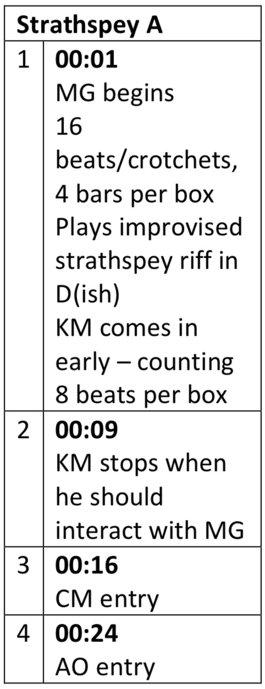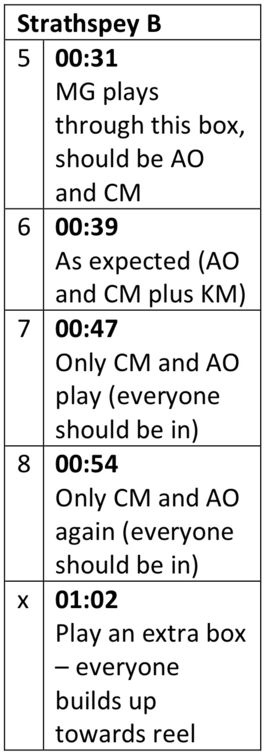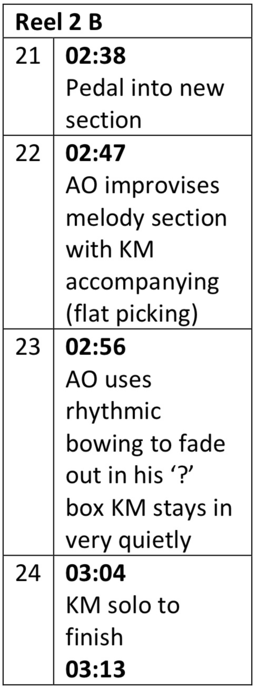Observations and analysis of Team A workshop, Score II
The performers immediately took a sense of space and energy from the score. Individual responses included assigning pitch and ‘area’ axes and imagining where the other musicians had situated themselves in the imagined space of the score.
With limited discussion and individual approaches rather than ensemble agreement, take 1 (of four) is fairly dissonant and utilises more free improvisation. With no direction other than the basic graphic table, and the previous performance of Score I, Team A created a cohesive performance that incorporated the basic elements of the score or piece: strathspey rhythms, reel phrases, a transition, playing individually (ignoring others), playing together (listening while playing and responding through playing) in various combinations, and a clear beginning and well-judged ending. The well-judged ending makes musical sense but none of the performers had reached what they thought was the end of the score. These were their first comments:
AO I was nowhere near the end.
MG Neither was I.
CM No, neither was I. That’s ok though.
[laughing]
. . .
KM I was kind of there so I was doing the second one down. (Team A 2008: 1)
After discussion between the group and some direction from me, the performances become tonal, more cohesive, and more representative of the information in the score, and therefore more representative of my intentions, as composer.
Unintentional misdirection: In this discussion between take 1 and take 2, I wrongly interpreted the circle as ‘playing all together with the group’, when you can see from the sketch in section 4. MAKING that I originally intended it to represent solo playing. This misdirection seemed to be understood by the performers and likely influenced their performances in Score II, takes 2, 3, and 4, towards more cohesive, ensemble playing. However, take 1 occurred before the misdirection was given and it is perhaps most clear in that take that the performers display a preference for cohesive musical performance over the information in the score. I chose to reinstate the circle as solo playing in the ‘final’ score, providing a key for the symbols on the score, as seen in section 7. FINDING.
Take 2 was one of the most interesting performances from a research perspective. I provide here some analysis of that negotiation and performance:
Due to the deviations from the score, it becomes problematic to analyse or represent the performance in a linear fashion. However, taking the intended sections of musical form, I can expose the performance in smaller sections, providing a breakdown of what took place from my perspective as composer and workshop facilitator.
Team A identified Score II as one strathspey and two reels, which allowed them to gauge the overall shape of the piece. However, there was some difference in how the musicians counted the number of beats – whether eight or sixteen – in each ‘box’, which led to the performers being separated in performance.
Discussion leading to take 2:
AO So it’s like, I imagined it twice round a strathspey.
MG Twice through a strathspey.
AO Just one strathspey and then . . .
MG Four times round a reel.
AO Or two reels.
LW Yeah, well I’m not gonna disagree with that. (Team A 2008: 4)
The musicians supported each other’s performance and musical intentions. Take 2 provides a clear example of this. As the musicians approach box 12, the last box of Reel 1A into Reel 1B, AO (O’Rourke – fiddle) builds up to launch into his solo section and moves to the major key. But MG (Green – accordion) enters early at the same point with a strong motif. AO almost immediately alters his playing from what would have been sixteen beats (four bars) of his own choice of solo playing to a series of rhythmic ‘stabs’/chords that respond to and complement what MG is playing.
The ensemble used clear cue points within Strathspey/Reel, such as ‘solo’ and silence moments, to navigate through the score, while a slightly darker line or mark on the page (the score has been tidied up now) disrupted their reading of the score. This can be heard in the recordings and was also mentioned in the workshop discussion:
AO So the strathspey bit’s in eight sections.
MG And then in the reel bit.
AO It’s in fifteen isn’t it?
MG Is that what it is, but the first five are in a box and the next ten aren’t.
AO Is that intentional?
MG We can’t ask Lori that. Oh, right well I’m wondering because it tapers, the line at the bottom is thin, let’s assume that that’s a . . .
AO Just a . . .
MG Thingy [irregularity in the hand-drawn graphic].
AO Thing yeah. (Team A 2008: 1)
KM I think we got a little bit, we kind of went away a bit I think and when we came back . . . We seemed to kind of drift and then come back together. I think we all came back together when it went to the all the circles.
AO But there should be a complete four bars of silence before the key change. (Team A 2008: 6)
They also used definite cue points within the score to perform a ‘piece’ from it. The silence mentioned above and seen in box 16 of the score (last box of Reel 1B) was an important cue point that allowed them to regroup. Team A emerged from the silence with so much confidence that this moment (Reel 1 into Reel 2) began to overshadow the moment of transition from strathspey to reel. Whereas, I had anticipated the strathspey–reel transition as the key moment in the score – hence all the interaction symbols at that point.
We can see (and hear) from this analysis that the performers played over the box lines in order to disengage from or build into whatever musical statement they were making. An example of this is the wandering accordion line from box 4 into box 5 as MG continues into Strathspey B rather than stopping.
In other takes, performers also played into boxes of silence in order to complete a musical statement or because they were engaged with the other performers ‘in the moment’ and chose not to abandon that.
CM Me? Well, I interpreted them as I felt like interpreting according to what was going on around, going on or sometimes I chose like maybe a little melodic thing and then transfer it down the harp but if there was something interesting going on I maybe chose to hook in with somebody and then do something that was still moving like this arrow. (Team A 2008: 1)
In informal, familiar terms: when they go wrong, Trad musicians ‘wing it’ until they find their feet again. A fairly standard practice that relies on excellent ear and communication skills, confidence in your musicality, and very fast judgement and reaction to what is happening around you. (Watson 2013: 144)
As the composer/deviser of the scores, I hoped the traditional musicians would bring to their performance of these scores the kind of knowledge that they would bring to the skeletal notation in a tune book. And this was the case to a large extent. (The scores could also be performed with traditional melodies, though none of my workshop participants chose to do this.) There was discussion of conventions in traditional music as the musicians interpreted the score and a desire not to sound ‘contrived’:
MG Can we decide to change key or is that contrived?
LW I don’t have any objection.
AO It’s not generally the way of it, strathspey, the reel would be in the same key.
MG No, but the two reels.
AO Oh right, yeah, let’s do that.
MG Or maybe someone should shout the key. That would be what would happen. (Team A 2008: 5)
One of the most important observations has been the desire of these traditional musicians for a cohesive musical event. While engaging with the score, each other, and their own musical and stylistic preferences, the musicians consistently chose to prioritise a performance that made musical sense – that seemed complete or had a recognisable shape or that simply felt good. This was echoed through the other workshops and in my own playing too.






